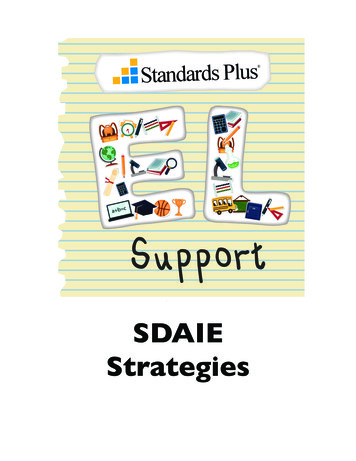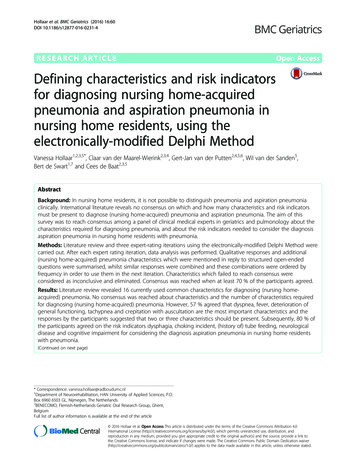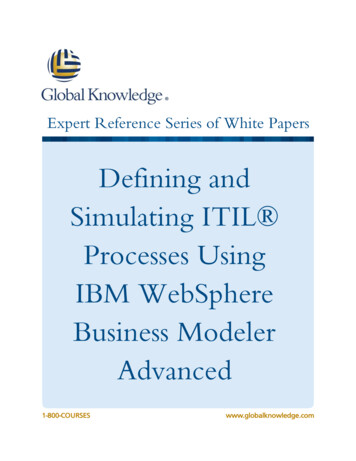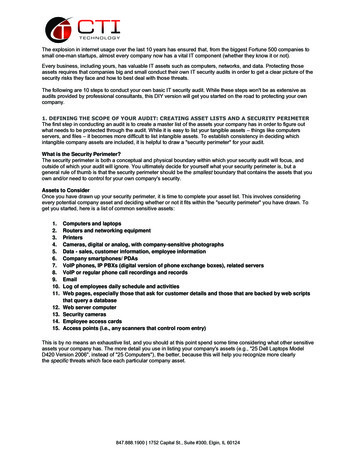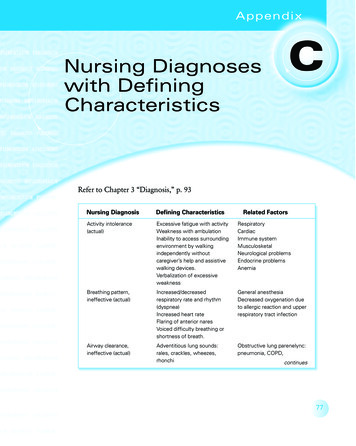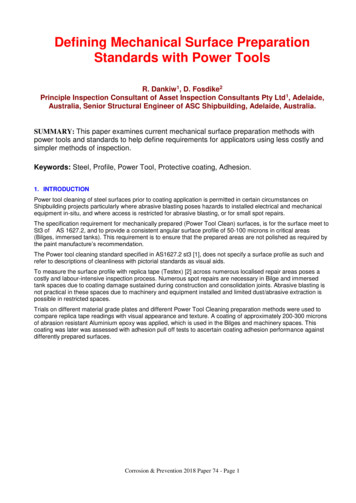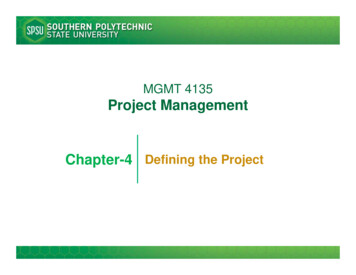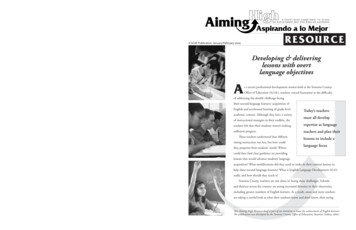
Transcription
8A im in g H ig h RE S O UR CEDefining ELD and SDAIEThe focus of English Language Development (ELD) is learning English. ELD iscore curriculum and should be taught everyday by a credentialed teacher. Instructionalcomponents include vocabulary, language forms(word and sentence structures), and languagefunction (the social and academic purposes forcommunicating with language).Specially Designed Academic Instruction inEnglish (SDAIE) is applied when teaching corecontent subjects to English learners. It is focusedon teaching specific academic content, but alsoincludes instruction that gives students access tothe language forms and functions being used indiscussions, texts, and resources related to thecontent learning. utwo-step equations, then the teacher uses numbers andmathematical symbols on a white board to representwhat they’ve just learned. For each teacher-guidedexample, the students are also asked to explain thesteps using transition words—first, next, then—andpresent-tense verbs.The teacher planned this lesson with two keylearning objectives in mind, one related to contentand the other related to language.nContent objective: Students will be able to solvetwo-step linear equations (3x 1 7), first usingthe math mat with “x” tiles, then on white boardsusing the “subtraction property of equality.”nLanguage objective: Students will be able toexplain the steps for solving two-step equationsusing transition words and the correct presenttense command verb form.Collaborative are modeling this idea by purposefullydeveloping lessons with overt language objectives. ForELD lessons, they are writing language objectives. Foracademic content lessons, both content and languageobjectives are planned. Objectives are purposeful, clearlybased on content and/or ELD standards, and matched tothe proficiency level of the students.While most schools are probably a year or two awayfrom adopting new English-Language Arts materialsthat will provide better resources for English learners,the teachers in the Collaborative are not waiting. Theyare acquiring the background knowledge and skills toimprove English learner instruction, and applying it intheir classrooms, to help their students right now.One of the beneficial aspects of the EnglishLearner Collaborative is that participating teachers arereceiving support for this effort from their peers. TheCollaborative has created a cross-county working groupwhose members are learning from each other as theypursue strategies for refining and improving instructionfor second-language learners. The idea of teacher-toteacher mentoring and peer support is not new, but hereit is focused on a priority issue for local schools—Englishlearner achievement.It’s important for teachers to remember that they arenot alone in addressing the English learner achievementgap. Through grade-level and content-area meetings,peer coaching, and initiatives like the Collaborative,every teacher has access to other experienced educatorswho are addressing the same challenge. Finding waysto share ideas, problem-solve together, and supportone another in implementing strategies for Englishlearner instruction is key. uDeveloping & deliveringlessons with overtlanguage objectivesAt a recent professional development session held at the Sonoma CountyOffice of Education (SCOE), teachers voiced frustration at the difficultyof addressing the double challenge facingtheir second-language learners: acquisition ofEnglish and accelerated learning of grade-levelacademic content. Although they have a varietyof instructional strategies in their toolkits, theToday’s teachersmust all developteachers felt that their students weren’t makingexpertise as languagesufficient progress.teachers and plan theirThese teachers understood that differentiating instruction was key, but how couldthey pinpoint their students’ needs? Wherelessons to include alanguage focuscould they find clear guidance on providinglessons that would advance students’ languageacquisition? What modifications did they need to make in their content lessons tohelp these second-language learners? What is English Language Development (ELD)This publication was developed by the Sonoma CountyOffice of Education in support of Aiming HighFor information, contact Patty Dineen, pdineen@scoe.orgreally, and how should they teach it?Sonoma County teachers are not alone in facing these challenges. Schoolsand districts across the country are seeing increased diversity in their classrooms,including greater numbers of English learners. As a result, more and more teachersare taking a careful look at what their students know and don’t know, then tryingReplicating the processGiven the demographics of our county’s studentpopulation, today’s teachers must all develop expertiseas language teachers and plan their lessons to includea language focus. The teachers in the English LearnerRESOURCEA SCOE Publication, January/February 20095340 Skylane BoulevardSanta Rosa, CA 95403(707) 524-2600nwww.scoe.orgThis Aiming High Resource brief is part of an initiative to boost the achievement of English learners.The publication was developed by the Sonoma County Office of Education; Suzanne Gedney, editor.
g the gap for English Learnersto determine what’s needed to move them towardbecoming proficient English speakers who areacademically equivalent to their peers.The need to modify programs, curriculum, andinstruction has spurred some teachers into action. Onepioneering group of 65 educators has been meeting overa period of months as part of a Sonoma County Officeof Education professional development initiative knownas the English Learner Collaborative. With a shared goalof improving instruction for second-language learners,these teachers are learning from classroom-experiencedEL specialists and from each other.Initially their focus was on instructional strategies,but soon they and the Collaborative organizers recognized that strategies alone weren’t enough. The teachersreally needed to re-purpose their lessons with alanguage focus, then plan instruction and selectstrategies to meet the specific learning goals theyhad set for their students.Focusing on languagewhen planning lessonsTeachersin the EnglishLanguage objectivesLearnerCollaborativecan vary widelyhave beendepending on theexperimentingwith a newlanguage proficiencyformat for thiskind of lessonof the targetplanning. Manystudents and theirhave adapted theprocess to theirdevelopmental ageown lesson planshorthand, butthe key idea theyare implementing is to purposefully develop anddeliver lessons with overt language objectives.Their lesson planning process begins withdetermining the purpose of the lesson, which may becontent-focused, language-focused, or both. In the sameway that lessons have been planned traditionally, theteachers identify the component parts of the instructionthey will provide. For the language portion of thelesson, they specify the language form—that is, thegrammatical structure of words or sentences—and thelanguage function—i.e., the language purpose orthinking process—that they want students to master.Next, the teachers identify the specific standardstheir lesson will address, including the English LanguageDevelopment (ELD) standards, correlating grade-levelEnglish-Language Arts (ELA) standards, and any othercontent standards that are applicable to the lesson.Key vocabulary words that will be taught are alsolisted on the lesson planning form.Brandy Raymond, a teacher and celdt coordinatorin the Roseland School District, prepared an ELD lessonfor kindergarten students using this planning process.She calls her lesson Red Leaf, Yellow Leaf after thebook by Lois Ehlert she’ll read to her students. She hasidentified “singular and plural” and “verb usage” as thelanguage forms for her lesson. She’ll teach these formsas the kindergartners learn the language function ofclassifying and explaining “how many.” The vocabularyfor this lesson includes simple words for things incontinued on page 4Designed Academic Instruction in English (SDAIE)model, which delivers content instruction along withinstruction related to the language forms and functionsstudents need to access that content.The integration of language and content objectivesis being practiced by teachers in the Cloverdale UnifiedSchool District. Here, a group of teachers is workingas a team to develop districtwide language objectivesfor lessons that also deliver science content. Several ofthese teachers have attended Collaborative trainings,then returned to their district to share what they’velearned with other staff. They’ve taught their colleaguesto write language objectives using commerciallyavailable form-and-function charts from Englishlearner specialist Connie Williams, Ed.D., and amatrix developed by ELD expert Susana Dutro.The teachers collaborate to plan multiple-weeklanguage objectives for science lessons. For example,one objectiveis for studentsto explainEnglish learners needwhat happenedin a sciencelanguage objectivesexperiment byusing past-tensefolded into bothverbs to describecontent lessons anda sequence ofactions.language lessonsThe teamdevelops aplanning sheetof proposed language objectives as a starting point fora three-week cycle of instruction, which individualteachers then incorporate into their daily lesson plans.At the end of the cycle, the staff reviews student achievement and plans new language objectives based onstudent need.In a second-grade classroom, a lesson for intermediate ELD students scaffolds a science experimentdesigned to demonstrate the impact of using more orless force. Students are actively engaged in pushing bottlecaps across a numbered game board, using differentdegrees of force. They add weight to the bottle capsby filling them with clay.The teacher provides a chart showing past, present,7Wendy Bedolla and Edmundo Fonseca, second graders inJefferson School’s intermediate ELD class, use sentence frames totell Cloverdale Superintendent Claudia Rosatti what happenedin their science experiment.and future tenses of verbs related to this game-likeexperiment. Using the words in the chart, the studentsmake predictions about the results they expect, thenreport on what happened after the actions are complete.They use the following sentence frames, filling in theproper verb tenses.nI (will push or pushed) the bottle cap tomake it move.nI (will get or got) two points.nThe cap (will move or moved) to the number 3.The teacher also addresses another languageobjective—using “more” and “less” before a noun ina sentence. Sentence frames like these provide guidedpractice:nI used force to move the object with clay.nI used force to move the object without clay.Another SDAIE example combining content andlanguage objectives can be seen in an algebra class foreighth- and ninth-graders. A lesson on solving two-steplinear equations from a Glencoe/McGraw Hill text isscaffolded for English learners at the intermediate andearly intermediate level of language proficiency. Thesestudents manipulate tiles on a “math mat” to helpthem visualize the mathematical thinking required for
A im in g H ig h RE S O UR CE6should be checked. If students arenot understanding, the teacher mustELD standards are not like content standardsre-teach, provide more practiceopportunities, or extend the lesson.nglish Language Development (ELD) standards are oftenIn some instances, lessons will needcalled “on-ramps to the highway” that lead students to theto be modified to develop studentEnglish-Language Arts standards. The ELD standards define whatunderstanding.students should know or be able to do in order to progress towardChecking for understanding shouldgrade-level English language skills.also encompass the idea of correctingELD standards are not written in the same manner as the Englishmisunderstandings and incorrectLanguage Arts standards. They’re based on broad descriptions oflanguage usage. This is particularlythe five English proficiency levels that cross all grade levels and areimportant because when Englishnot specific to the lexicon, syntax, rules, and structures of Englishwithin these bands of proficiency. That’s because students withinlearners don’t learn language correctlythe proficiency bands may have very different instructional needs.and continue to make the samemistakes, it’s harder for them to acquireFor example, early intermediate English learners in the primarygrades will require very different instruction than early immediateproper usage. For instance, if a studentstudents in middle school, since they differ so significantly in theirconsistently says “he” instead of “she”functional use of language. uand is not corrected, that student maynever learn to use these words properly.The final component of checkingfor understanding is providing a formal assessmentChecking for understandingactivity at the conclusion of the lesson. This assessmentWhen developing and delivering lessons to meetshould give students the opportunity to demonstratethe needs of English learners, a teacher’s goal is to:proficiency in what they have just learned. When someor all of the lesson objectives are language related, then Get and keep students engaged.assessment shouldn Provide opportunities for students to practicealso be focused onlanguage usage.students’ use ofA key strategyn Extend learning through multiple speakinglanguage.and writing activities.for teachers isEnAdvance student proficiency.nAssess student learning to determine ifobjectives were met.One strategy that greatly strengthens languagefocused lessons is frequent checking for understanding.This can be as simple as careful listening to students’ oralresponses, moving from table to table to check writtenwork, monitoring pair-share and group work, and askingquestions to ascertain students’ level of comprehension.Teachers should always incorporate checking forunderstanding strategies in their lesson plans.Checking for understanding must be donethroughout a
kind of lesson planning. Many have adapted the process to their own lesson plan shorthand, but the key idea they . are implementing is to purposefully develop and deliver lessons with overt language objectives. Their lesson planning process begins with determining the purpose of the lesson, which may be content-focused, language-focused, or .
